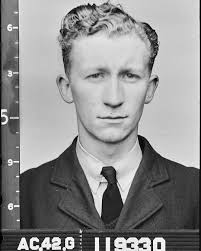Carlton Community History Group
News
Stories of Service and Sacrifice
Carlton During World War 2

Image: NAA: A9301, 119330
Joseph Anthony Battanta of Princes Hill
Patrick Ferry from National Archives of Australia gave an outstanding presentation at the Kathleen Syme Library & Community Centre, 251 Faraday Street, Carlton, on 24 May 2025. Patrick is the Project Manager for the Digitising Services Team (Defence Services Records) of the National Archives. The topic was stories of service and sacrifice by volunteers from the Carlton area during World War Two. The case studies brought history to life as well as illustrating the methodology of the National Archives. Military historians were among those who attended. This presentation was part of an ongoing Carlton Community History Group collaboration with the Kathleen Syme Library & Community Centre. The venue offers meeting rooms available for booking and a café nearby.
The public can access digitised service records online at www.naa.gov.au or by ordering original records held in Melbourne for viewing at the Victorian Archives Centre, 99 Shiel Street, North Melbourne. The reading room is co-located with the Public Record Office of Victoria and open from Wednesday to Friday from 10.00 am to 4.30 pm.
Seventy Years of Weaving and Spinning
The Handweavers and Spinners Guild of Victoria celebrated its 70th anniversary in 2024 and has a long association with Carlton and North Carlton. The Guild was originally established as the Victorian branch of the New South Wales Guild in 1952. As interest and membership grew, the Guild became a not-for-profit organisation in its own right. The first meeting was held at the Public Library (now State Library of Victoria) in April 1954. For the next nine years, the Guild met at several city locations and in 1963 moved to the Loyal Orange Lodge at 524 Elizabeth Street, Carlton. There was another move in 1971 to the Horticultural Hall (popularly known as "Horti Hall") in Victoria Street, opposite Trades Hall. In the 1980s, the Guild became part of the wider craft movement at the Meat Market Craft Centre (MMCC) in North Melbourne. This was not to last, as the MMCC closed suddenly in 1999.1
In 2000, the Guild had to find new premises and the site chosen was in North Carlton. The scout hall at 12 to 18 Shakespeare Street dates back to the 1930s. The foundation stone was laid by the Lord Mayor Councillor Luxton in July 1930. The hall was purpose-built for public performances, with a raised platform, off-stage dressing rooms and cloakrooms. It served a dual purpose in providing a home base for the First Carlton Troop and also a source of income from hiring out the premises for public and private functions. When the Guild moved in, the building was a bit run down and had problems with water damage, but it provided a large open space for classes and workshops and a single storey setting. No need to carry bulky weaving looms and spinning wheels up and down the stairs.2
By 2011, the building was long overdue for renovation, and also required for scouting activities. Once again, the Guild had to find another home. This was a two-storey building at 655 to 657 Nicholson Street, North Carlton, a 1970s structure with a retail shopfront on the ground floor and a gym above. While not a heritage building, the new location offered more exposure in a local business and shopping precinct, with ready access to public transport. The Guild is expanding its floor space in 2025 by leasing the ground floor of the adjacent building at 653 Nicholson Street. This will provide improved access and facilities for classes and workshops. The two storey shop and its neighbour at 651 were built for Louisa Jones in 1888. The first occupants were the Harmsworth Brothers, painters & decorators, followed by a succession of businesses – confectioner, greengrocer, jeweller, cycle depot, optician, pawnbroker, chemist, real estate agent and restaurants offering a variety of cuisines. The most recent businesses have been the Koca Lane salon and Moosa Bar.3
Adding up the years, the Handweavers and Spinners Guild of Victoria has spent nearly half of its lifetime in Carlton and North Carlton, and has woven its way into our history.
1 Paramanathan, Elizabeth. Arachne's Children, 2006
2 The Argus, 21 July 1930, p. 7
3 Building ownership and occupancy information sourced from land title records, the Victorian Heritage Database, Sands & McDougall directories and newspaper advertisements.
More on Shakespeare Street